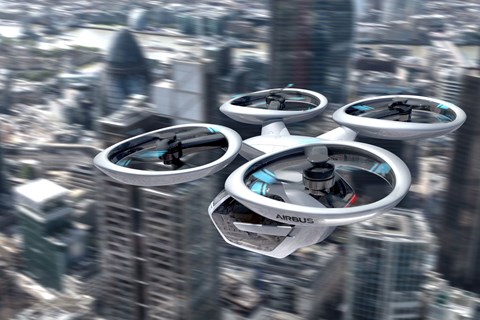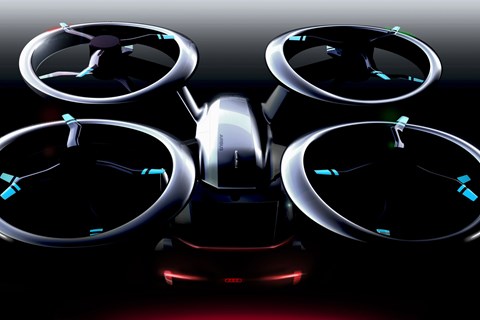► Joint effort from Audi, Airbus and ItalDesign
► Concept uses separate modules for flexibility
► Flying cars finally set for launch?
As always, Geneva’s delivered an action-packed motor show in many respects, but hasn’t 2018 been a bit lacking on the truly wacky concept front? Enter the ItalDesign Pop.Up Next – a flying car designed and engineered in cooperation with Airbus… and Audi.
Vorsprung durch TAKE-OFF!

If the name’s familiar that’s because the original ItalDesign and Airbus Pop.Up first appeared at the 2017 Geneva motor show last year. Now it’s back in evolved Next form with Audi on board the project as well, suggesting this isn’t quite the random flight of fancy you might have first thought.
What is the Pop.Up Next flying car?
Design-wise, it looks very much like a super-enlarged drone, with not only a wheel at each corner but a pair of rotors as well. Yes, that’s eight in total.
Functionally, it’s a two-seater like a basic Smart car, given vertical take off and landing (VTOL) capability by the caged-in blades. These are not permanently attached, however, but part of a separate ‘air module’ that can be removed when not required.

In fact, even the ‘capsule’ – that’s the passenger compartment – and the ‘ground module’ – which allows it to drive along the road – are separate components.
As such it’s described as a ‘modular, multi-modal system that enables transportation to enter into the third dimension,’ and in the process avoid traffic congestion.
Yeah. Right.
Where does Audi come into this?
Audi’s added a bit of design nous – particularly inside – but its more significant contributions are in the areas of battery technology and autonomous driving.
Heavy hint dropped, this thing is indeed fully electric as well as fully certifiable.
How fast and how far will the Audi flying car go?
The wannabe tech spec for the air module features no fewer than eight 20kW electric motors, delivering a total power output of 160kW – equivalent to around 215bhp. This is apparently enough for a top speed of 75mph.

Sadly, the 70kWh battery pack only delivers a 31-mile flight range, so you won’t be hopping over the traffic for long. Charging time is only 15 minutes, but that won’t be much comfort if you suddenly find yourself out of juice mid-air.
Back on terra firma, the ground module is specced with 60kW of electric power – 80bhp – directed to the rear wheels. Using 15kWh of battery it would apparently go for 81 miles between 15-minute charges, but can only reach a top road speed of 62mph.

As you can imagine, being as light and as strong as possible is important here, and much of the structure is titanium.
Are they serious?
It is rather hard to imagine anyone successfully pulling this off – there are surely far too many regulations in the way of flying cars now, though perhaps preventing the people inside from taking control with all that Audi autonomous tech will help.
But a lot of very considered thought and effort does seem to be going into the project, with Airbus in particular taking pains to actually go proof of concept on the – literal – aerodynamics. ItalDesign also gets quite specific about the locking mechanism used to join the modules together.

The interior is a mix of Airbus Airspace cabin design and typical Audi queues – the integration of which was left to the aircraft company.
We wish them the best of luck, but would perhaps prefer not to volunteer for the first round of test drives.

A-Z of the Geneva motor show on CAR magazine